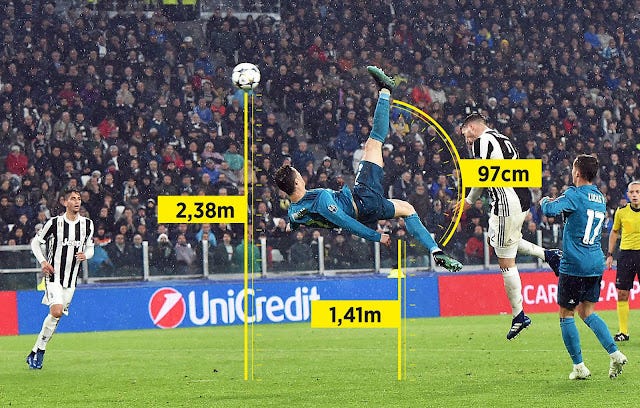3 Football moments that pushed the laws of physics
Physics of Football explained...
When I score, I don’t celebrate. It’s my job. Does a postman celebrate when he delivers post? - Mario Balotelli
Greetings, fellow bohron
Physics is everywhere. The moment you unsee its beauty, the universe conspires a plot to make you realize how universal are the physical laws and how much they help you in your daily tasks even when you think they don’t. The same applies to Football, the world’s most loved sport.
So sit back and relax. You are about to unleash the magnificent physics behind three of the most incredible moments in the history of the sport.
The ‘Impossible’ Free Kick

On 3 June 1997, in an international match against France, Brazilian left-back Roberto Carlos won a free-kick from 40 yards out. Facing a four-man wall from such a great distance, a direct goal seemed impossible. But this guy had something else in mind. He hit the ball with huge power only to direct the shot wide of the post. But just before the ball reached the line, it hooked to the left and landed in the back of the net. He had scored the greatest free-kick goal in the history of the sport.
How did he do it?

According to Newton’s first law, a body continues to be in a specific state of motion in a particular direction unless an external force causes it to change its state.
So how did the ball change its direction in a blink of an eye?
The secret lies in the spin imparted to the ball at the time Carlos hit it. The kick caused the ball to spin in a counterclockwise fashion. The flow of the air on both sides of the ball caused it to slow down a bit. On the left of the ball, airflow was in the direction of the spin creating a region of low pressure. On the right, the airflow was against the direction of spin creating a region of high pressure.
This pressure difference caused the ball to curve inwards as a result of the Magnus Effect, first described by Newton in 1672.
The goal was hailed as a ‘miracle’ by scientists and it made Carlos an absolute immortal of the game.
For a better view of the goal, watch it here.
Leo Messi’s Solo Goal

In the 2005 Copa Del Ray Final against Athletic Bilbao, Barcelona talisman Lionel Messi received a pass just past the midfield. What he did next, was just out of this world. He covered a distance of 60 yards in just 11 seconds beating 6 defenders and the GK to score from 14 yards out from a sufficiently tight angle. In the process, he managed to clock an incredible 0 to 19.5 mph in just 2.7 seconds! Imagine if his teammate Suarez blocked the shot, it would have been awful.
How did he do it?
The physics of dribbling involves very simple high school physics but to achieve it requires a lot of practice.
The centre of gravity (CoG) of the human body is a hypothetical point around which the force of gravity appears to act. It is a point at which the combined mass of the body appears to be concentrated.
The lower the COG, the more difficult it is to shift the weight of the body outside its base of support and hence more stable it is. And Messi is just 5’7”, 3 inches shorter than even me(oops, I think I just revealed my height!). So he was essentially created by God to teach the world how to dribble.

Analyzing the situation so fast, reacting to it with precise coordination of legs and eyes while maintaining his balance isn’t a child’s play and Messi has been doing this for years.
He achieved a similar feat in the 2007 Copa Del Ray semi-final against Getafe. Back then, he was just 20 years old! These two goals are often considered the greatest ever in the history of the sport. Undoubtedly, the GOAT.
For a better view of the goal, watch it here.
CR7’s Bicycle Kick

In the 2018 UEFA Champions League quarter-final against Juventus, Real Madrid started a quick counter-attack after winning the possession. Dani Carvajal crossed the ball inside the box only to direct it behind Cristiano Ronaldo. Realizing that a header is out of reach, he turned back to swing his whole body mid-air and hit a breathtaking bicycle kick. Even Juventus fans celebrated it! Surely, the greatest goal of Ronaldo’s career.
Thanks to Gigi Buffon for blocking Vazquez’s shot, else we would have never witnessed this spectacular moment.
How Did He Do it?
Bicycle Kicks are one of the most beautiful occurrences in football but executing them perfectly requires a thorough knowledge of the rotational dynamics.

Energy
To impart a huge amount of kinetic energy to the ball, the legs need to be swung across as far as possible to store the maximum amount of potential energy.
Rotational Inertia
Rotational inertia is the property of a body to resist any change in its state of angular motion.
The rotational inertia is calculated as the product between the body mass and the squared distance from the body to the centre of rotation. The more you curl your body or bend your legs, the lower the rotational inertia and easier it is to rotate.
Angular Velocity
It is a measure of how fast a body rotates about a fixed point.
Analysis revealed that to power the ball like Ronaldo did, an angular velocity of about 300 revolutions per minute was required. That’s around the exact speed of a helicopter’s rotating blades!

In a nutshell, scoring with this technique takes a lot of practice. Cristiano himself tried and failed for a whole decade before finally providing this unforgettable moment. An absolute genius.
Watch this goal from all possible angles here.
As beautiful as this game is, such unforgettable moments make us all dream of achieving similar feats. But physics teaches us that nothing comes easy. Now that you know the science of these techniques, go try them today. Joga Bonito!





Very Very Interesting
Great explanation and info👏